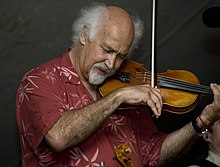| Cajun music | |
|---|---|
| Stylistic origins | Ballads of the French-speaking Acadians of Canada |
| Cultural origins | Late 18th century Cajuns in Louisiana; German culture |
| Typical instruments | Cajun accordion, fiddle, steel guitar, guitar, triangle, harmonica, bass guitar, upright bass. In the 1930s string band era: mandolin, banjo. |
| Subgenres | |
| Black Creole | |
| Fusion genres | |
| Swamp pop, Zydeco | |

Cajun fiddle music is a part of the American fiddle music canon. It is derived from the music of southwest Louisiana and southeast Texas, as well as sharing repertoire from the Quebec and Cape Breton Island traditions. [1] It is one of the few extant North American folk music traditions rooted in French chanson. [2] According to Ron Yule, "Louisiana fiddling had its birth roots in Europe, with fiddling being noted as early as the 1400s in Scotland". [3] Zydeco music is a geographically, culturally, and musically related style.
Cajun music
Cajun music, an emblematic music of Louisiana, is rooted in the ballads of the French-speaking Acadians of Canada. Cajun music is often mentioned in tandem with the Creole-based, Cajun-influenced zydeco form, both of Acadiana origin. These French Louisiana sounds have influenced American popular music for many decades, especially country music, and have influenced pop culture through mass media, such as television commercials. It is an aural tradition dating past the Acadian conquest of southwest Louisiana after their displacement from Nova Scotia, whence they brought a rich musical tradition. [4]
Blues fiddle has been directly influential in the development of Cajun fiddling, as with all music in the New Orleans music scene, and even proto- bluegrass influences from early American balladry. [5]
History
According to Bill Malone and David Sticklin, authors of Southern Music/American Music, Cajun music was first discovered commercially in the 1920s with release of Allons à Lafayette (Let's Go to Lafayette). [6][ page needed] By 1928 Cajun fiddle had already diverged into variegated styles. The most prominent proponent was Leo Soileau of Ville Platte, Louisiana, who started recording in 1928 with Mayuse Lafleur, accordionist, who "met his death from a stray bullet in a tavern brawl in October of that same year". [7] The fiddle was the central instrument in Cajun sound until the twenties when it was somewhat eclipsed by the accordion, both in Canada and the United States. In the early 1930s strings once again dominated. Mandolins, pianos, and banjos joined fiddles to create a jazzy swing beat strongly influenced by the western swing of Texas. [8]
Repertoire
Cajun fiddle includes quadrilles, jigs, hornpipes, reels, one-steps, two-steps, airs, mazurkas, schottisches, and waltzes. [3]
" Jambalaya" is based on a Cajun melody and has been covered by musicians of all genres, including Aldus Roger, Jo-El Sonnier and even a 1971 rock version by the young Bruce Springsteen [9] Hank William's recording of the song is so influential it is covered in and of itself, as by Dwight Yoakam. [10]
Prominent proponents of the style
- Dewey Balfa
- Al Berard
- Breaux Brothers
- Hadley Castille
- Harry Choates
- Varise Conner
- Sady Courville
- Luderin Darbone
- Michael Doucet
- Wade Fruge
- J. B. Fuselier
- D'Jalma Garnier
- Doug Kershaw
- Gundula Krause
- L'Angélus
- Dennis McGee
- Rufus Thibodeaux
References
- ^ Dôle, Gérard; Vadunthun, Marie-Paule; D. S. Smith (1982). "Bayou Memories: Louisiana French Folk Songs and Dance Tunes" (PDF). Folkway Records. OCLC 51479374. Retrieved 2011-09-11.
- ^ Reiner, David; Anick, Peter (1989). Old Time Fiddling Across America. Pacific, Missouri: Mel Bay Publications. ISBN 978-0-87166-766-3.
- ^ a b Yule, Ron (2005). "Louisiana's Living Traditions: Fiddling in Louisiana". Louisiana Division of the Arts: Department of Culture, Recreation & Tourism. Retrieved 2011-09-11.
-
^
Aginsky, Yasha; producer (1983).
Les Blues de Balfa (16 mm film). Aginsky Productions with Les Films Cinetrie and Les Films d'Ici.
OCLC
24289884. Retrieved 2011-09-11.
We are here to tell you a little bit about what a Cajun is. A Cajun is a person who his homeland was France. Went into Nova Scotia, at the time Acadia, and settled there and was there for about a hundred years, and afterwards the British took over the territory and then the French-speaking people, the French descendants, known as the Acadians, came down to the South-Western part of Louisiana, and that was back in 1755. So over all of these years, your language, and your music has been preserved from daddy to son or daddy to daughter or momma to daughter.
- ^ Balfa, Dewey; Tracey Schwarz (1982). "Cajun Fiddle Old and New with Dewy Balfa" (PDF). Folkway Records. OCLC 51479374. Retrieved 2011-09-11.
- ^ Malone 1979.
- ^ Malone 1979, p. 61.
- ^ Malone 1979, p. 62.
- ^ Marsh, Dave (2006). Bruce Springsteen on tour, 1968-2005. New York: Bloomsbury. p. 45. ISBN 1596912820.
- ^ Yoakum, Dwight (June 4, 2000). Dwight Yoakam – Jambalaya (On the Bayou). Retrieved 2011-09-11.
Bibliography
- Malone, Bill C. (1979). Southern Music, American Music. Lexington: University Press of Kentucky. ISBN 978-0-8131-0300-6.